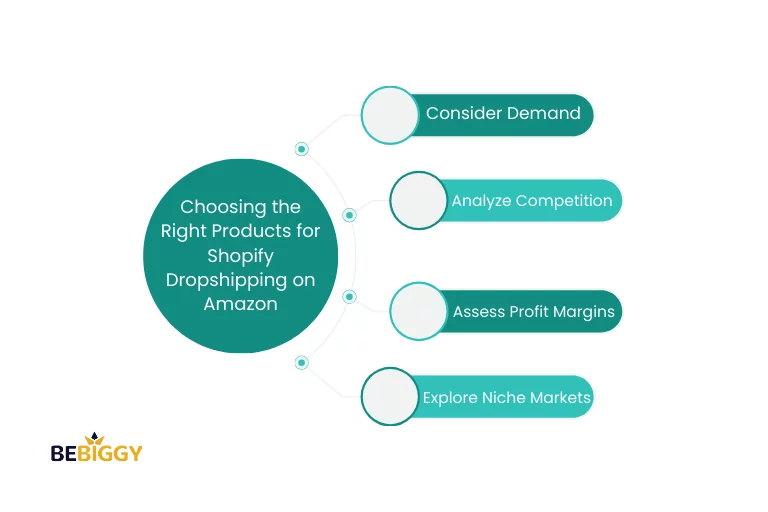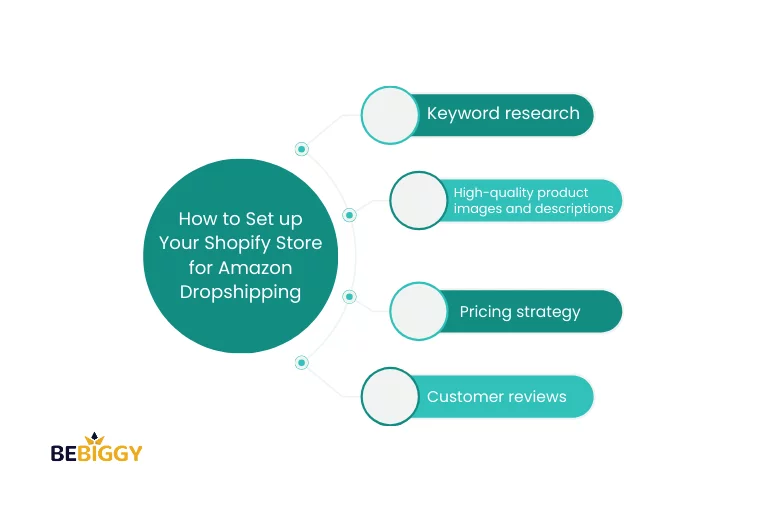Shopify dropshipping on Amazon offers a convenient and profitable solution for entrepreneurs and online retailers looking to expand their reach and tap into the vast customer base of Amazon. By leveraging the power of Shopify and the extensive reach of Amazon, sellers can maximize their sales and grow their business like never before.
This article delves into Shopify Dropshipping on Amazon, covering setup steps, niche selection, success stories, and actionable tips for success. Whether you’re an experienced Shopify store owner or a newcomer, this guide will equip you to harness the potential of this profitable online business model.
Overview of Shopify Dropshipping on Amazon
What is Shopify Dropshipping?
Shopify dropshipping is a business model that enables you to sell products without keeping inventory or handling shipping. Instead, you partner with suppliers who handle these aspects for you. Setting up an online store and automating the process with dropshipping apps is easy with Shopify.
Understanding the Shopify-Amazon Integration
The Shopify-Amazon integration is a powerful e-commerce solution that allows Shopify store owners to expand their reach by seamlessly listing and selling products on the Amazon marketplace.
This integration streamlines inventory management, order processing, and product synchronization, making it easier for businesses to tap into Amazon’s vast customer base while managing their operations from the familiar Shopify dashboard. It enables sellers to access Amazon’s massive online audience, grow their sales, and enhance their e-commerce presence.
Amazon’s marketplace boasts a staggering 310 million active users on a global scale. Notably, Amazon.com consistently welcomes a whopping two billion visitors every month. In March 2023 alone, this e-commerce giant recorded an impressive 2.4 billion visitors, as reported by Similarweb. These remarkable figures firmly establish Amazon.com as the world’s most frequented e-commerce platform. Furthermore, it ranks as the fourth most visited site in the United States and holds 13th in global website popularity.
Steps to set up Shopify Dropshipping on Amazon
- Create a Shopify Store: Start by setting up your online store on Shopify. Customize your online store with a catchy domain name and a theme that reflects your brand identity.
- Install the Amazon Sales Channel App: Install the Amazon Sales Channel app on your Shopify dashboard. This app seamlessly connects your store with your Amazon seller account.
- List Your Products on Amazon: Use the Amazon Sales Channel app to list your products on Amazon. To attract customers, it’s important to optimize your product descriptions and images. Ensure they are well-crafted and visually appealing to increase the chances of a customer purchasing.
- Configure Inventory and Pricing: Set your inventory levels and pricing preferences in your Shopify dashboard. Sync this information with Amazon to ensure accurate stock availability and pricing.
- Start Selling and Managing Orders: Once your products are listed, you can begin selling on Amazon. Any orders placed on Amazon will automatically flow into your Shopify dashboard, allowing you to manage and fulfill them quickly.
By following these steps, you can quickly and efficiently set up Shopify Dropshipping on Amazon, expanding your business reach and maximizing your sales potential.
Choosing the Right Products for Shopify Dropshipping on Amazon

Regarding Shopify dropshipping on Amazon, choosing the right products is crucial for success. By identifying profitable niches and using the right product research tools, you can increase your chances of finding winning products to sell.
Identifying profitable niches for Amazon Dropshipping
- Consider Demand: Evaluate products with consistent demand and popularity in the market. This ensures a reliable customer base and potential sales growth without seasonal fluctuations.
- Analyze Competition: Research the competition within the niche. Opt for niches with moderate competition, indicating market potential but not oversaturation, which might make it hard to stand out.
- Assess Profit Margins: Prioritize products that offer higher profit margins, as this is crucial for the profitability of your Amazon dropshipping business. Look for items where you can maintain a healthy profit even after expenses and fees.
- Explore Niche Markets: Venture into niche markets with sustainable demand but less intense competition. While the customer base might be smaller, it can provide an opportunity to establish your brand and expertise.
Identifying profitable niches for Amazon dropshipping requires balancing demand, competition, and profit margins. The key is to find products with consistent demand, manageable competition, and attractive profit potential.
Product research tools for finding winning products
There are several product research tools available that can help you find winning products for Shopify dropshipping on Amazon. These tools provide valuable data and insights to make informed decisions.
- Jungle Scout: A tool for product research that lets you filter by sales, reviews, and revenue. It helps you uncover trending products, analyze competitors, and identify potential opportunities, streamlining your product selection process.
- Helium 10: This tool offers various features, including product and keyword research, and listing optimization. It provides comprehensive data to help you find profitable products and optimize your Amazon listings effectively.
- Keepa: An invaluable tool for tracking product price history and sales rank. It assists you in understanding product trends and spotting items with consistent demand, ensuring you make informed product choices.
Utilizing these product research tools can save time and increase your chances of discovering successful products for your Shopify dropshipping business on Amazon. When dropshipping on Amazon, selecting the right products is crucial for success and expanding your reach.
How to Set up Your Shopify Store for Amazon Dropshipping

Combining Shopify and Amazon is an effective strategy for expanding reach and increasing sales. By setting up your Shopify store for Amazon dropshipping, you can tap into Amazon’s vast customer base and take advantage of its efficient fulfillment network. Here’s what you need to know to get started.
Integration between Shopify and Amazon
The first step to integrate your Shopify store with Amazon is to use apps or plugins designed for this purpose. These tools seamlessly sync your product listings, inventory, and orders between the two platforms. Proper integration allows you to manage your Amazon inventory directly from your Shopify dashboard, saving you time and effort.
Optimizing your Shopify store for Amazon sales
Optimizing your Shopify store is crucial to optimize your Amazon sales. Here are tips:
- Keyword research: When searching for products on Amazon, it’s important to identify relevant keywords that customers are likely to use. Incorporate these keywords strategically into your product titles, descriptions, and tags to improve visibility.
- High-quality product images and descriptions: Invest in professional product photography and create compelling descriptions that highlight the unique selling points of your products. This will not only attract customers but also build trust and credibility.
- Pricing strategy: Research the competition and determine competitive yet profitable product prices. Remember that Amazon customers are often price-sensitive, so finding the right balance is crucial.
- Customer reviews: Motivating your customers to share positive feedback for your products on Amazon is highly recommended. Positive reviews boost your credibility and improve your search rankings, making it more likely for customers to discover your products.
By following these steps and continuously optimizing your Shopify store for Amazon sales, you can expand your reach and increase your sales potential.
Sourcing Products for Amazon Dropshipping with Shopify

Dropshipping offers an attractive opportunity for ambitious entrepreneurs seeking to expand their reach through Amazon. You can find a variety of Amazon dropshipping products and suppliers through Shopify’s platform. Here are some key points to consider when sourcing products for Amazon dropshipping with Shopify.
Finding reliable suppliers for Amazon Dropshipping
When selecting suppliers for your dropshipping business, reliability is crucial. Here are a few steps to help you find reliable suppliers:
- Research: Take the time to research and vet potential suppliers. Look for established companies with a good reputation and positive customer reviews.
- Communication: Suppliers should be contacted to ensure they are responsive and willing to work with dropshippers. Clear communication is crucial.
- Product Quality: Ensure that the suppliers you choose provide high-quality products. This will reduce the likelihood of negative reviews and returns while improving customer satisfaction.
- Shipping and Delivery: Consider suppliers that offer fast and reliable shipping options. Amazon strongly emphasizes timely delivery, so it’s essential to work with suppliers that can meet these requirements.
Using fulfillment services for efficient order processing
To manage your dropshipping business effectively, consider using fulfillment services offered by Shopify or third-party providers. These services can streamline order processing and inventory management, allowing you to focus on marketing and customer service. Some benefits of using fulfillment services include:
- Automation: Fulfillment services automate order processing, inventory updates, and shipping notifications, saving you time and effort.
- Inventory Centralization: Consolidate your inventory in a fulfillment center, making managing and fulfilling orders easier.
- Scalability: As your business grows, fulfillment services can handle increased order volumes without additional resources or infrastructure.
By leveraging reliable suppliers and efficient fulfillment services, you can streamline the process of sourcing products for Amazon dropshipping and focus on expanding your reach and growing your business.
How to Manage Inventory and Fulfillment for Amazon Dropshipping with Shopify
As an entrepreneur looking to expand your reach and increase sales, integrating Shopify with Amazon is a powerful strategy. By dropshipping on Amazon using Shopify, you can leverage the benefits of both platforms and reach a wider audience.
Inventory management strategies for successful Amazon Dropshipping
Efficient inventory management is crucial when dropshipping on Amazon to ensure smooth operations and customer satisfaction. Here are some strategies to consider:
- Real-time inventory sync: Syncing your Shopify store with Amazon allows for automatic updates of inventory levels. This helps prevent overselling and ensures accurate stock availability for customers.
- Track supplier inventory: Regularly communicate with your suppliers to stay informed about their stock levels. This text enables you to update your inventory to prevent selling out-of-stock products.
- Set reorder points: Analyze sales data to determine when to reorder products. Setting reorder points helps you stay proactive and maintain optimal stock levels to fulfill customer orders.
Streamlining fulfillment processes for better customer experience
Efficient fulfillment processes are vital to provide a seamless customer experience and maintain positive seller metrics on Amazon. Consider the following tips:
- Automate order fulfillment: Utilize Shopify’s integration with Amazon to automate order fulfillment. This ensures that orders placed on Amazon are automatically forwarded to your Shopify store for processing and shipment.
- Utilize fulfillment services: Fulfillment by Amazon (FBA) is a popular option for Amazon sellers. By utilizing FBA, you can store your products in Amazon’s warehouses and let them handle the packaging, shipping, and customer service aspects of the order.
- Monitor shipping and delivery: Stay on top of shipping and delivery updates to ensure timely and accurate fulfillment. Please communicate with your shipping carriers and use tracking numbers to give customers real-time information about their orders.
By implementing effective inventory management and streamlining fulfillment processes, you can successfully expand your reach and provide a positive shopping experience for customers when dropshipping on Amazon with Shopify.
Optimizing Listings for Amazon SEO and Sales

When it comes to expanding your reach as a Shopify dropshipper, leveraging the immense customer base of Amazon is a smart move. However, optimizing your listings for both Amazon SEO and conversions is crucial to truly maximize your sales potential.
Amazon SEO best practices for higher rankings and visibility
It’s critical to adhere to these recommended practices to raise your chances of ranking better in search results and gaining greater awareness on Amazon:
- Keyword Research: Thorough keyword research is necessary to gain insights into the particular terms and phrases potential customers use to search for comparable products. Strategically include these keywords in the listing title, bullet points, description, and backend search phrases.
- Optimized Product Title: Craft a concise title with relevant keywords. Ensure it accurately describes your product and highlights its key features and benefits.
- Informative Bullet Points: The main attributes, details, and advantages of your product should be highlighted using bullet points. Again, include relevant keywords to improve your search rankings.
- Compelling Product Description: Write an effective and detailed product description that provides all the necessary information and highlights what sets your product apart from competitors.
Crafting compelling product listings to boost conversions
While optimizing for Amazon SEO is essential, it’s equally important to create product listings that persuade potential customers to purchase. Here are some tips to help you craft compelling listings:
- Professionally Written Content: Invest in high-quality copywriting that effectively communicates your product’s value and benefits. Make sure to address any concerns or objections that potential buyers may have.
- High-Quality Images: Use high-resolution pictures that highlight the benefits of your product and display it from various perspectives. Images that are clear and professional can dramatically boost conversions.
- Customer Reviews: Encourage customers to leave honest reviews to build credibility and influence buyers.
By following these best practices for Amazon SEO and crafting compelling product listings, you can enhance your visibility, increase sales, and take full advantage of the vast customer base on Amazon.
Promoting Your Shopify Dropshipping Products on Amazon

When it comes to expanding your reach and boosting sales for your Shopify dropshipping business, leveraging the power of Amazon can be a game-changer. With millions of potential customers actively searching and buying on Amazon, it’s crucial to promote your products on this platform effectively. Here are some key strategies to consider:
Effective marketing strategies for boosting traffic to your Amazon listings
- Optimize your listings: Start by ensuring that your product listings on Amazon are fully optimized. This involves using pertinent keywords in your descriptions, bullet points, and titles. Pay attention to your product images, making them visually appealing and informative.
- Utilize Amazon SEO: Understanding and implementing Amazon SEO tactics can help improve your product visibility within Amazon’s search results. To find relevant, high-volume keywords and thoughtfully use them in your listings, conduct keyword research.
- Leverage social media: Make use of social media networks to promote your goods and draw customers to your Amazon listings. Engage your audience by providing educational content, client comments, and exclusive deals. Additionally, you might want to think about running targeted ads on websites like Facebook and Instagram.
Utilizing Amazon PPC ads for increased exposure and sales
- Amazon Sponsored Products: Set up Amazon Sponsored Products campaigns to advertise your products directly within Amazon’s search results. This pay-per-click (PPC) advertising model can help increase exposure and drive targeted traffic to your listings.
- Keyword targeting: Conduct thorough keyword research to identify relevant and high-converting keywords for your Amazon PPC ads. Use these keywords to optimize your campaigns and maximize their effectiveness.
- Monitor and optimize: Regularly analyze the performance of your Amazon PPC campaigns and make necessary adjustments. Monitor your ad spend, click-through, and conversion rates to ensure you get the most out of your advertising budget.
You can efficiently advertise your Shopify dropshipping products on Amazon, drive more attention to your listings, and eventually raise your sales and profitability by putting these tactics into practice.
Analyzing Data and Scaling Your Shopify Dropshipping Amazon Business
For entrepreneurs looking to expand their reach and increase profitability in the world of e-commerce, leveraging the power of both Shopify and Amazon can be a winning combination. However, monitoring and analyzing key metrics is essential to ensure sustainable growth and success.
Monitoring and analyzing key metrics for growth and profitability
To effectively scale your Shopify dropshipping Amazon business, you must closely monitor important metrics that drive growth and profitability.
- Sales and Revenue: Track your total sales and revenue figures to understand trends and patterns. This data will help you identify your most successful products and marketing strategies.
- Conversion Rate: Monitor your conversion rate, which measures the percentage of visitors who make a purchase. A low conversion rate may indicate issues with your website design or marketing campaigns that need optimization.
- Customer Acquisition Cost (CAC): Knowing how much it costs you to acquire new customers is crucial for evaluating the profitability of your business. Calculate your CAC by dividing your marketing costs by the number of new customers acquired.
Scaling your Amazon Dropshipping business with Shopify
Once you’ve gathered and analyzed the necessary data, it’s time to scale your business effectively with Shopify. Here are some strategies to consider:
- Expand Product Catalog: Identify products with high demand and profitability potential and add them to your Shopify store. Keep your product range diverse to attract a broader customer base.
- Optimize Inventory Management: Efficiently managing your inventory is essential to avoid stockouts or excess inventory. Utilize inventory management software and tools to streamline the process.
- Marketing and Advertising: Invest in targeted marketing campaigns to reach a larger audience. Utilize social media advertising, search engine optimization (SEO), and email marketing to boost visibility and conversions.
- Enhance Customer Experience: Focus on delivering exceptional customer service to foster loyalty and positive word-of-mouth. Implement strategies like fast shipping, easy returns, and personalized communication.
By continuously monitoring your key metrics and implementing effective scaling strategies, you can take your Shopify dropshipping Amazon business to new heights of success and profitability.
The Benefits of Shopify Dropshipping on Amazon

- Expanding Your Reach: Amazon is one of the largest online marketplaces, with millions of customers actively searching for products. Integrating your Shopify store with Amazon can significantly boost sales by tapping into a vast customer base.
- Effortless Inventory Management: Shopify’s integration with Amazon allows you to sync your inventory seamlessly. This means that Shopify automatically updates your inventory when an order is placed on Amazon, ensuring you never oversell products.
- Streamlined Order Fulfillment: With Shopify Dropshipping, the fulfillment process becomes simplified. When a customer places an order on Amazon, Shopify takes care of the entire process, from packaging and shipping to tracking and delivery, allowing you to focus on growing your business.
- Brand Control: Unlike selling directly on Amazon, where your brand takes a backseat to the Amazon brand, using Shopify allows you to maintain control over your brand identity. You can customize your online store, create a unique customer brand experience, and establish a strong brand presence.
- Profit Margins: Dropshipping eliminates the need for upfront investment in inventory. This allows you to operate with lower overhead costs, resulting in higher profit margins. You can also experiment with different products and niches without the risk of being stuck with unsold inventory.
Common Mistakes to Avoid in Shopify Dropshipping on Amazon

Identifying common pitfalls and misconceptions in Amazon Dropshipping
When expanding your reach in e-commerce, Shopify dropshipping on Amazon can be a game-changer. However, there are several common mistakes that many entrepreneurs make along the way. By identifying these pitfalls and misconceptions, you can avoid them and increase your chances of success.
- Lack of Research: One of the biggest mistakes is failing to do thorough research before entering the Amazon dropshipping market. Understanding the platform’s rules, policies, and requirements is essential to avoid potential penalties or account suspensions.
- Poor Product Selection: Choosing the wrong products for dropshipping can lead to low sales and unhappy customers. Analyzing market trends, competition, and customer demand is crucial to identify profitable and in-demand products.
- Inadequate Branding: Neglecting to build a strong brand presence can hinder your success in the long run. Investing in professional product images, compelling product descriptions, and a user-friendly website can differentiate your brand and build customer trust.
Tips to overcome challenges and ensure success
To navigate the world of Shopify dropshipping on Amazon successfully, here are some tips to keep in mind:
- Conduct Comprehensive Market Research: Understand your target audience, identify profitable niches, and research your competitors to gain a competitive edge.
- Optimize Your Listings: Use relevant keywords, compelling titles, and high-quality images to optimize your product listings and improve visibility in Amazon’s search results.
- Focus on Customer Service: Building customer loyalty requires providing top-notch customer service. Aim for favorable feedback and reviews, respond quickly to customer questions and concerns, and offer smooth returns.
- Adapt and Evolve: The e-commerce landscape is constantly evolving, so be prepared to adapt your strategies accordingly. Stay updated on industry trends, leverage data and analytics, and make changes to optimize your business performance.
By implementing effective strategies and avoiding common mistakes, you can increase your chances of success with Shopify dropshipping on Amazon.
Real Success Stories in Shopify Dropshipping on Amazon
Success stories and case studies within the realm of dropshipping serve as beacons of inspiration and invaluable sources of insight. They spotlight the extraordinary achievements of entrepreneurs who have skillfully expanded their reach through the powerful synergy of Shopify and Amazon. These real-world narratives are not only a testament to the potential of this business model but also a source of valuable lessons.
Case Study 1: Mastering Product Selection
John’s Journey to Success
John, a determined entrepreneur, embarked on his dropshipping journey using Shopify. Initially, he struggled to find his footing, experimenting with a wide range of products. However, his breakthrough came when he harnessed the tools to conduct meticulous product research.
- Leveraged platforms like Jungle Scout, Helium 10, and Keepa for product research.
- Identified a niche with steady demand and low competition.
- Utilized Amazon listings powered by Shopify integration.
- Optimized product listings for visibility and appeal.
- Combined effective research and listing optimization for success.
John’s story is a testament to the transformative impact of product research and the potential to identify profitable niches by leveraging the right tools.
Case Study 2: Scaling Operations with Automation
Sarah’s Strategic Move
Sarah, another Shopify dropshipper, was at a crossroads when her business began to flourish. With an expanding product catalog and increasing orders, she realized that manual order fulfillment would soon become overwhelming. Her solution lay in automation.
- Utilized apps for efficient order management.
- Integrated Shopify with Amazon to streamline order fulfillment.
- Automated the fulfillment process with suppliers for timely deliveries.
Saved time and enhanced customer satisfaction through efficient order processing.
Sarah’s case study underscores the importance of scaling through automation when experiencing growth in the Shopify dropshipping ecosystem.
Case Study 3: Leveraging the Power of Marketing
Michael’s Marketing Marvel
Michael, an astute marketer, recognized that the success of his Shopify dropshipping business was intrinsically tied to his ability to attract and engage a broad audience. To achieve this, he explored the built-in email marketing features of Shopify.
- Crafted personalized email campaigns with promotions, discounts, and new product highlights.
- Nurtured customer relationships and encouraged repeat purchases through these engaging campaigns.
- Leveraged social media integration and advertising on platforms like Facebook and Instagram.
- Expanded reach to a broader audience, enhancing the impact of marketing efforts.
The strategic use of these marketing tools increased his reach and propelled his Shopify dropshipping business to new heights.
These real success stories and case studies exemplify the potential of Shopify dropshipping on Amazon. They showcase the significance of product selection, automation, and marketing in achieving growth and success. By drawing inspiration from these stories, aspiring dropshippers can glean valuable insights into what’s possible and embark on their own journeys of expansion and triumph.
FAQs on Shopify Dropshipping on Amazon
Is dropshipping worth it?
Yes, the worth of dropshipping is a subjective matter, influenced by several factors. It offers benefits like lower upfront costs, reduced inventory risks, and the ability to start an e-commerce business easily. However, whether it’s worth it depends on your business strategy, marketing efforts, and customer service. Some dropshippers find it highly profitable, as they manage to identify unique products, set competitive prices, and provide excellent customer experiences. In contrast, others might face stiff competition in oversaturated niches, resulting in lower profit margins.
Can you use Amazon with Shopify dropshipping?
Yes, it’s possible to use Amazon in conjunction with Shopify dropshipping. By integrating your Shopify store with Amazon, you can expand your product range and potentially reach a broader audience. This integration allows you to leverage Amazon’s vast customer base and increase your business’s visibility. However, it’s essential to follow Amazon’s policies and ensure seamless order management to make the most of this combination.
Is dropshipping allowed on Amazon?
Yes, dropshipping is permitted on Amazon, but sellers must adhere to Amazon’s Dropshipping Policy. This policy emphasizes delivering a positive customer experience. Dropshipping sellers on Amazon need to meet specific requirements and follow guidelines to maintain compliance. By providing excellent customer service and ensuring timely order fulfilment, dropshippers can operate successfully within Amazon’s marketplace.
Can Amazon fulfil Shopify orders?
Yes, Amazon can fulfil Shopify orders through a process called multi-channel fulfilment. This involves sending your Shopify orders to Amazon’s fulfilment centers, where they pick, pack, and ship the products to your customers. While this can streamline order fulfilment, ensuring proper inventory management and seamless integration between your Shopify store and Amazon’s fulfilment services is essential. Additionally, consider the associated costs and fees, which can impact your overall profitability when using Amazon for fulfilling Shopify orders.
Is Amazon dropshipping profitable?
Yes, the profitability of Amazon dropshipping is achievable with the right approach. Success in Amazon dropshipping hinges on careful product selection, competitive pricing, and efficient order fulfilment. With thorough market research and by identifying products with untapped potential, sellers can carve out a profitable niche. However, it’s crucial to know that profitability can vary significantly, as Amazon is a highly competitive marketplace. Success often requires ongoing adaptability and staying ahead of competitors.
What is the difference between Shopify dropshipping and Amazon dropshipping?
The primary difference between Shopify dropshipping and Amazon dropshipping lies in the platform and business model.
Shopify dropshipping involves creating your own online store using the Shopify platform and partnering with suppliers to fulfill orders. You have more control over branding, product selection, and customer relationships, but you’re responsible for marketing and driving traffic to your store.
On the other hand, Amazon dropshipping means using Amazon as your sales platform. You can list your products on Amazon’s marketplace and ship them directly to buyers upon order placement. Amazon handles traffic and customer trust, but you have less control over branding and customer data.
How to dropship on Amazon?
To dropship products on Amazon, follow these steps:
- Create an Amazon seller account.
- Choose a niche and research products.
- Find reliable suppliers for dropshipping.
- Create product listings on Amazon.
- Price products competitively.
- Optimize product titles, descriptions, and images.
- Fulfill orders promptly through suppliers.
- Provide excellent customer service.
- Monitor and manage your Amazon store for growth.
Conclusion
Expanding your reach by utilizing Shopify dropshipping on Amazon can be a game-changer for your business. It allows you to tap into the vast customer base of Amazon while taking advantage of the convenience and flexibility offered by Shopify.
Recap of the benefits and potential of Shopify Dropshipping on Amazon
By leveraging this business model, you can benefit in several ways:
- Increased customer reach: Amazon has millions of active users, giving you access to a broader audience and the potential for increased sales.
- Reduced risk and upfront costs: Dropshipping eliminates the need to invest in inventory upfront, reducing the risk associated with traditional retail models.
- Convenience and scalability: With Shopify, managing inventory, order fulfillment, and customer support becomes streamlined. As your business expands, easily scale by adding products and reaching more customers on Amazon.
- Building your brand: While selling on Amazon, you can still establish your brand identity through product listings, packaging, and customer experience.
Actionable steps to start and excel in this business model
To get started and excel in the Shopify dropshipping on Amazon business model, follow these steps:
- Research niche products: Find profitable product niches with high demand and low competition. Look for products that align with your target audience and have a healthy profit margin.
- Set up your Shopify store: Create a professional-looking Shopify store and optimize it for conversions. It should have an appealing design, easy navigation, and a seamless checkout process.
- Source reliable suppliers: Identify trustworthy suppliers who can fulfill your orders efficiently and deliver high-quality products to your customers.
- List your products on Amazon: Optimize your product listings on Amazon by using relevant keywords, compelling product descriptions, and high-quality images.
- Market and promote your products: Drive traffic and boost sales with social media ads, influencer collabs, and SEO.
- Monitor and analyze performance: Regularly track your sales, customer feedback, and ad campaigns to identify areas for improvement and make data-driven decisions.
By following these steps and continuously refining your strategy, you can establish a successful Shopify dropshipping business on Amazon and expand your reach.











 What Is Shopify Dropshipping and How Does It Work?
What Is Shopify Dropshipping and How Does It Work?  Shopify Dropshipping: What You Need to Know Before Buying a Business?
Shopify Dropshipping: What You Need to Know Before Buying a Business?  How to Dropship on Shopify: Step-by-Step Guide
How to Dropship on Shopify: Step-by-Step Guide  Guide to Finding Reliable Shopify Dropshipping Suppliers [100% Success]
Guide to Finding Reliable Shopify Dropshipping Suppliers [100% Success]